What Metrics Need to Be Met to Reopen Scarsdale Schools?
- Details
- Written by: Joanne Wallenstein
- Hits: 4763
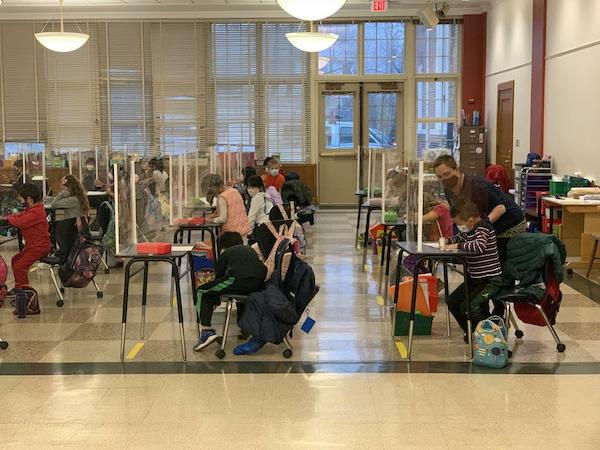 With so many neighboring districts reporting plans to re-open schools full time as well as the availability of vaccines for teachers and indications from the NYS Health Commissioner that the six foot social distancing requirement may be relaxed, many are wondering what’s holding Scarsdale back from re-opening the schools?
With so many neighboring districts reporting plans to re-open schools full time as well as the availability of vaccines for teachers and indications from the NYS Health Commissioner that the six foot social distancing requirement may be relaxed, many are wondering what’s holding Scarsdale back from re-opening the schools?
Ardsley, Bronxville, Briarcliff, Byram Hills, Chappaqua, Dobbs Ferry, Eastchester, Harrison, Hastings on Hudson, Mt. Vernon, New Rochelle and Rye are either in school full time or have announced plans to transition to full time school in the next few weeks. In Scarsdale, elementary school students will return to school, however the Middle School is only moving to 2 days and alternate Wednesdays on March 17 and the High School is going from 2 half days to 2 full days in school on March 8.
Plastic Barriers
We learned that the district has purchased plastic partitions and thought that might be a sign that a fuller return to school was in the offing, however the information we received from Superintendent Thomas Hagerman offers no timeline and makes no guarantees. Here are responses from Hagerman received on March 1, 2021:
(Q) The parents shared the news that the district has purchased 4,200 barriers to be used for grades 3-12. Will these be installed soon or are they intended for the fall?
(A) So far we have spent approximately $180K in total for barriers as follows:
-Mid/Late Summer 2020: $53,000 - 660 barriers primarily for special education settings and one for each classroom for one on one instruction if needed. Also for offices. Prices were extremely high at this point and time was of the essence.
-Late-Fall 2020: $32,000 – 1,200 barriers for k-2 students primarily used at lunch.
-Early-Feb (on order): $93,000 – 4,200 barrier for grades 3-12 primarily to be used at lunch and instructionally as determined by teachers.
-An additional $2,000 for miscellaneous other barriers needed along the way related to all of the above
(Q) Howard Zucker has indicated that the state is re-examining the six-foot rule and says he wants to get kids back in school. Will this change the district’s plans?
(A) If the NYSDOH changes the social distancing requirement to say, 3ft., this will not change plans--which has always been to get all kids back in school as soon as it is safe to do so for students and teachers--but it would certainly accelerate our timeline.
(Q) I am sure you are aware that many Westchester districts have now announced plans to fully re-open in March and April. Do you expect Scarsdale to follow suit?
Like other districts, we have been planning for a full return throughout this process. The availability of vaccinations for faculty and staff is new risk mitigation that we will believe will help us lessen six-foot social distancing and get us back into school more quickly.
Metrics
Since the beginning of the crisis, parents requested a list of required metrics that, if reached, would enable full-time school to open. Concise criteria for opening were never presented, but one fact was clear. Both the administration and the Board of Education insisted that the school’s physical plant could not accommodate the full school population at six feet apart as required by the NYS Department of Health.
Social Distancing
When parents repeatedly questioned calculations that showed there was insufficient space inside the buildings, the administration invited district architect’s BBS to present their plans at an 11/16/20 Board of Education meeting. At the time, Architect Kevin Walsh of BBS shared his schematics for the layout of two sample elementary school classrooms, one at Heathcote and another at Edgewood. Walsh showed desks placed six feet apart with 56 square feet of space per occupant. According to Walsh, the layout must allow for two means of egress from each classroom. For a classroom of 785 square feet, 14 students could be accommodated along with a teacher and an aid. Depending on the number of teachers and aids, an additional student or two could be added.
Relying on these calculations the board and the administration spent months claiming that this was a major hurdle for full time school.
Frustrated with the architect’s analysis, Scarsdale resident Irin Israel obtained floor plans of the elementary schools and used a graphic approach to draw in the desks in the rooms. He quickly noted that desks that bordered the walls of the rooms did not need six feet of distance on the side abutting the wall, saving considerable space.
However, when he presented his renderings to the district, they failed to acknowledge his solutions. He wrote to the Board and administrations saying, “Comparing the architect’s square footage method (which was used to make all layout determinations and decisions this past summer and fall) to the graphic method (which I presented on 11/9/20), the graphic method allowed for an additional 507 kids to fit in our Scarsdale schools at six-foot distancing (17% more children).
Then suddenly, on February 9, 2021 Superintendent Thomas Hagerman announced that students in grades three through five would return to school in March, following grades K-2 on November 30, 2020. This meant that the elementary schools would be fully populated with students and staff.
Explaining the change in direction, Dr. Hagerman made a distinction between six feet of social distancing and remaining “functionally six feet apart.” Here is what his email said.
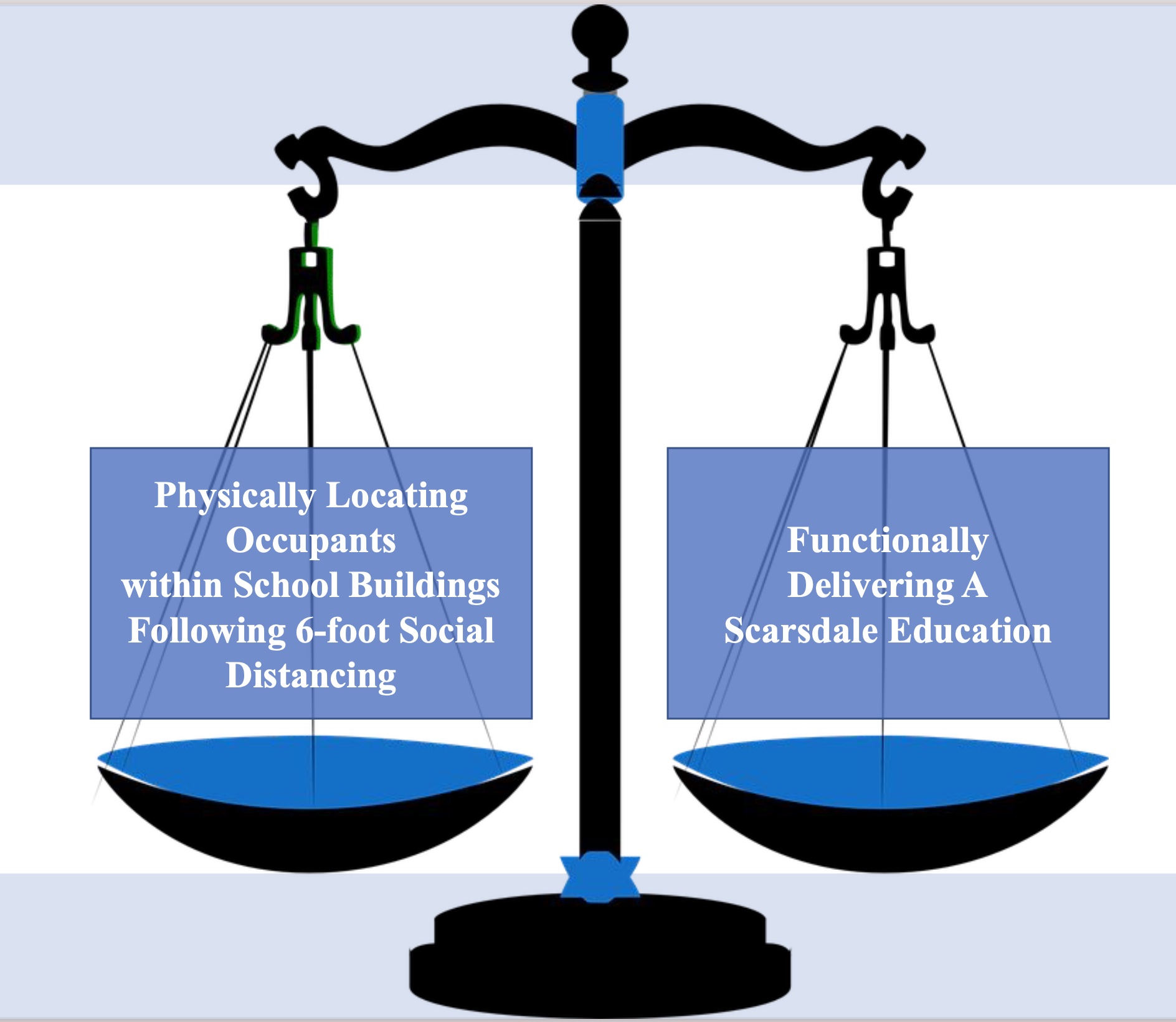 A report from District Architects BBS dated January 8, 2021 showed that the full school populations of each elementary school could safely attend school.
A report from District Architects BBS dated January 8, 2021 showed that the full school populations of each elementary school could safely attend school.
“Specifically, how can students fit back into our buildings when we were told they could not because of the need for six-foot social-distancing? The answer is that students could not have fit all this time and remained functionally six feet apart. The idea of social-distancing focuses on reducing the contact between all individuals in an environment. In our assessment, this concept goes beyond the measurement of six feet between desks to encompass the full range of functions necessary to run a school. The new arrangement moves from a more cautious application to accepting a purely mathematical interpretation of 6 feet of distance. This represents a fundamental change in our application of social-distancing, and, at least partially, weakens one of our core mitigation efforts. We resisted this for some time primarily because of health and safety promises we had made to the staff and community, but also because we did not have confidence in our ability to run “school” safely and effectively, given the complex intricacies of a typical day.”
Now a response to a FOIL request from Israel, reveals that the district was aware that there was adequate space in the schools for all elementary school students to be social distanced at six feet. In fact, the administration received a report from district architects BBS dated January 8, 2021, that demonstrated how the rooms could be laid out to give students and teachers ample space. Why the change in the numbers?
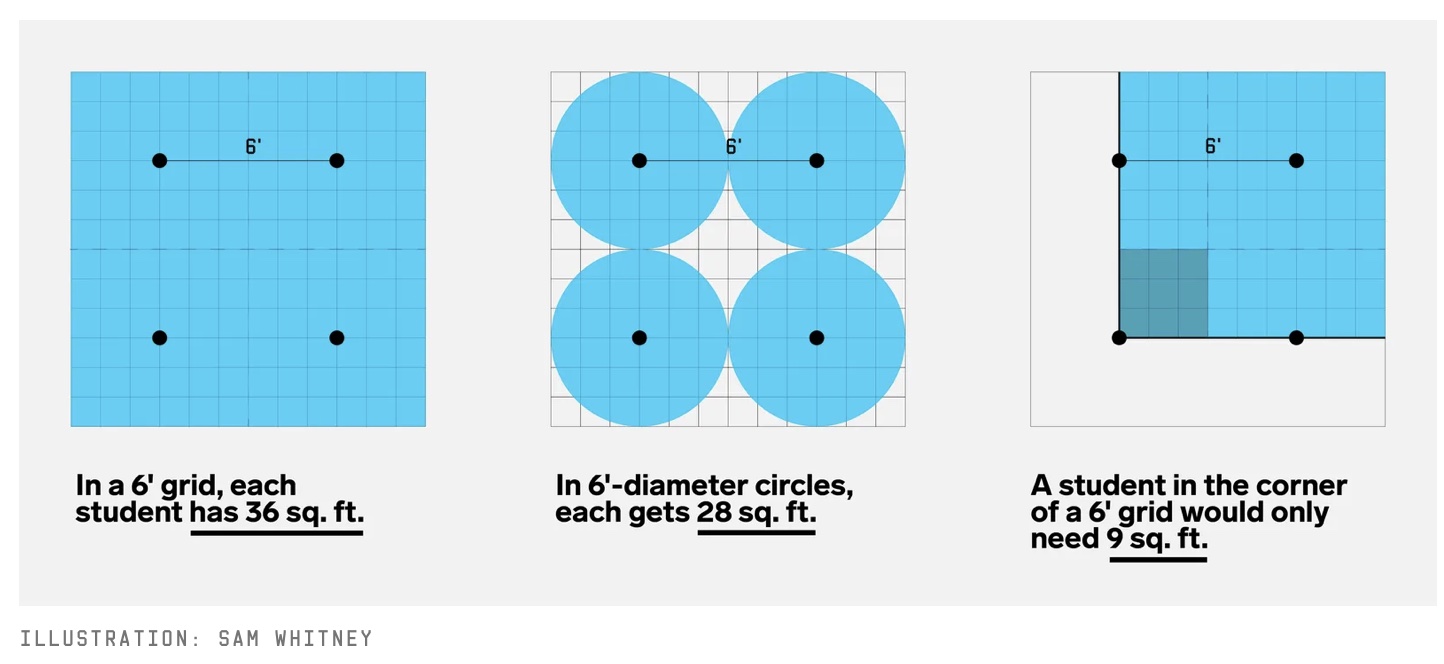 An analysis from Wired Magazine shows that 56 square feet of space per student is far more than is needed to maintain 6 feet of social distancing.It appears that the architects initially used a simple mathematical calculation to determine how many students could safely fit into schools. Architects assumed that each student would need 56 square feet of space, and they took that number, divided it by the total square footage of the school and calculated the number of people that could be safely placed in the building. That figure of 56 square feet was far higher than the 44 square feet used by neighboring districts –and 44 square feet was later determined to also be too high. See the analysis here:
An analysis from Wired Magazine shows that 56 square feet of space per student is far more than is needed to maintain 6 feet of social distancing.It appears that the architects initially used a simple mathematical calculation to determine how many students could safely fit into schools. Architects assumed that each student would need 56 square feet of space, and they took that number, divided it by the total square footage of the school and calculated the number of people that could be safely placed in the building. That figure of 56 square feet was far higher than the 44 square feet used by neighboring districts –and 44 square feet was later determined to also be too high. See the analysis here:
In the report from the architects dated January 8, they compare the square footage method to the graphic method and determine that all students and teachers could safely attend school, and there would still be remaining open spaces. In the most extreme example, only 22 rooms at Greenacres would be needed, leaving 18 rooms including the learning commons, gym and new multipurpose rooms open for use.
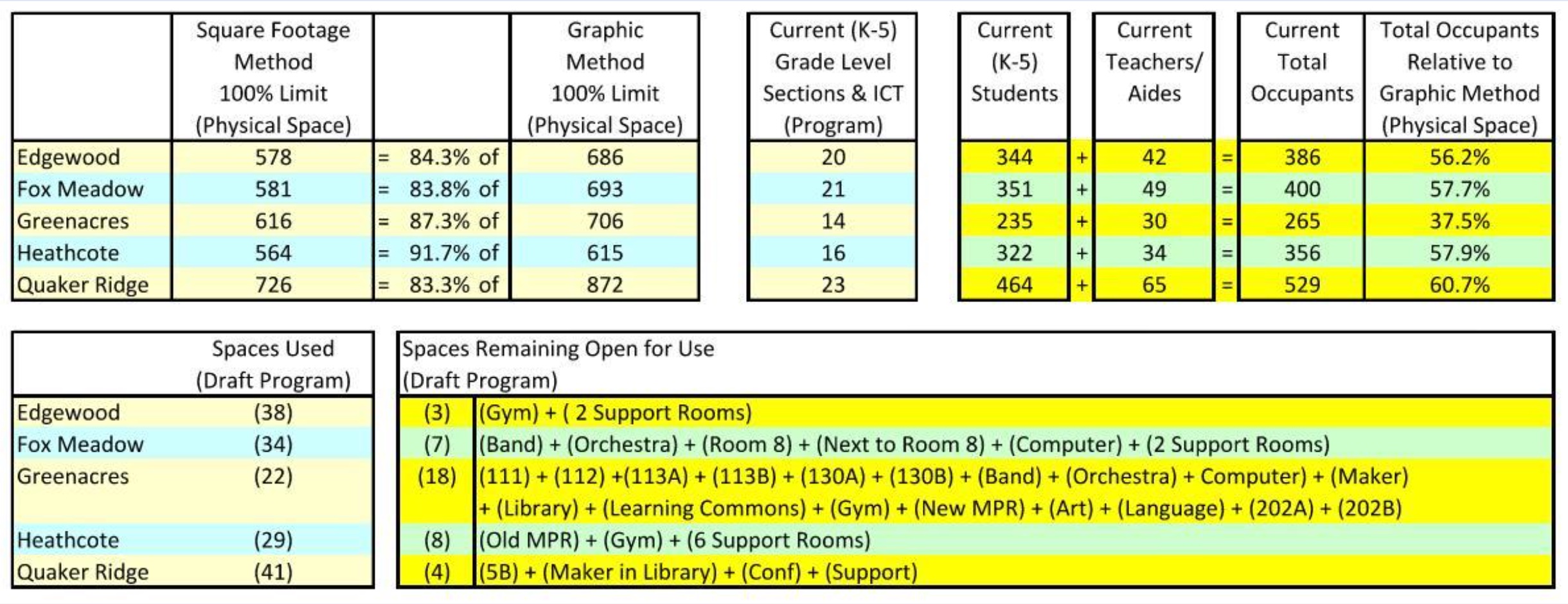 January 8, 2021 analysis from BBS Architects
January 8, 2021 analysis from BBS Architects
However, as far as we know, the administration did not share this report with the Board of Education and did not make it available to the public.
With this new information in hand, Israel shared it with Board of Education and asked the following:
1) Comparing the architect’s square footage method (which was used to make all layout determinations and decisions this past summer and fall) to the graphic method (which I presented on 11/9/20), the graphic method allowed for an additional 507 kids to fit in our Scarsdale schools at six-foot distancing (17% more children).
2) 40 rooms, including some large rooms like gyms, would be unused and not needed for classes (but could be used for other purposes) even with all children fitting at six-foot distancing. 40 empty rooms.
3) Zero rooms need more than capacity (at six feet), only 12 rooms total in the 5 schools would be 100% capacity (at six feet), and 79% of rooms used would be at 80% or less of capacity (at six feet).
Basically, it’s not even close.
Before you yell “density!”, keep in mind that we have yet to hear any metrics of density and where the line between safe and unsafe lies.  Sign on Fenimore RoadRegardless, with these drawings, while the school density would obviously increase, the density per classroom would not increase at all.
Sign on Fenimore RoadRegardless, with these drawings, while the school density would obviously increase, the density per classroom would not increase at all.
I spent much time this past fall illustrating exactly what these documents show, and here, it is unequivocally proven true: that all current in-person Scarsdale elementary children can fit full-time at six feet and have been able to fit since the beginning of the school year.
1) Is BBS Architects the correct district architect for Scarsdale? This architect has blatantly dropped the ball by using a sub-par mathematical equation to position the children in our schools. This was a simpler and less effective method, rather than doing the full work to assess the maximum capacities within the safety regulations. Their information misled the district and community and affected many critical decisions this year.
2) After denying the truth of this information, the District learned the truth on 1/8/21, yet did not share this pertinent information with the community nor the Board. In fact, I would suggest that the administration would not have revealed this information to the Board had it not been for my request, since they had not revealed it until my request was being filled 7 weeks later. This is further lack of transparency. This is information that must be used to judge the Administration’s performance in attempting to follow the Board’s policy directive of getting the children back into school full-time safely and according to the regulations this year. It is critical that this information be used when judging the performance of the current Superintendent and Administration this school year.
What’s Next?
The district’s lack of transparency, even with the Board of Education, is puzzling. Why did they conceal this information? What other factors are preventing the opening of the schools? What is the district’s agreement with the teachers’ union? With adequate social distancing, a supply of plastic barriers and staff vaccinations in place, what are the reasons for not reopening schools?
As the weeks go by, and many grow increasingly frustrated with ZOOM school, social isolation and fears for their children, many parents are waiting for answers.
SHS Students Invited to Apply for Students Inside Albany Program
- Details
- Written by: Joanne Wallenstein
- Hits: 1945
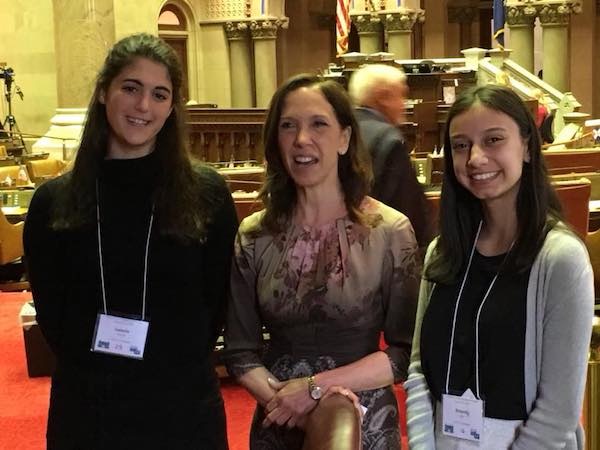 For the 10th consecutive year, the League of Women Voters of Scarsdale will select two high school students to attend the annual Students Inside Albany Conference to take place on Friday, May 21st from 4:00-6:00PM and Saturday, May 22nd from 10:00AM-4:30PM. Any Sophomore, Junior or Senior student who attends Scarsdale High School or who resides in the school district is eligible to apply.
For the 10th consecutive year, the League of Women Voters of Scarsdale will select two high school students to attend the annual Students Inside Albany Conference to take place on Friday, May 21st from 4:00-6:00PM and Saturday, May 22nd from 10:00AM-4:30PM. Any Sophomore, Junior or Senior student who attends Scarsdale High School or who resides in the school district is eligible to apply.
This year, Students Inside Albany will be a virtual event designed to immerse students in the process by which public policy is proposed, revised and enacted in New York State. Similar to past years, the agenda will be packed with tools to instruct students on how to influence public policy decision-making at the state level. Similarly, the highlight of the in-person program of meeting with legislators will continue, as the League will arrange virtual meetings in small groups with state legislators to discuss issues and advocacy.
Scarsdale students who attended this program in the past were unanimous in their enthusiasm about the program.
The Students Inside Albany Conference will continue to be free for students to attend.
Applications and more information are available on the LWVS’s website under the Youth Programs tab (https://lwvs.org/students-inside-albany-2021/) and are due by March 3, 2021.
Please contact LWVSyouthprograms@gmail.com for more information.
District Presents First Pass at Proposed 2021-22 School Budget
- Details
- Written by: Sammy Silberberg
- Hits: 2180
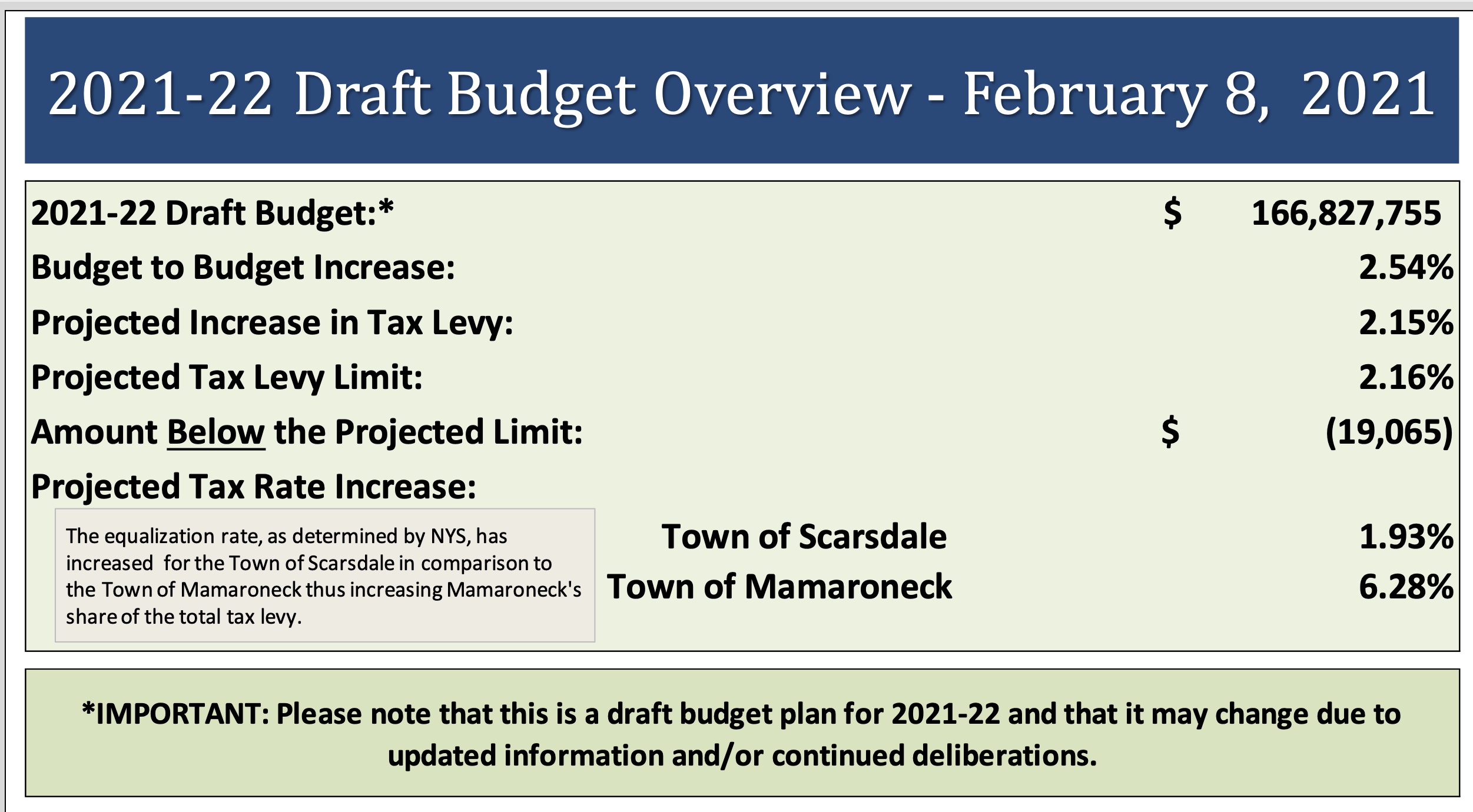 Hopeful that the 2021-22 school year will return to normal, the Scarsdale Schools held their first budget study session for the proposed 2021-22 school budget on Monday, February 8, 2021 via Zoom. Though the budget assumes kids will be back in school, the district is also including contingency funds for two remote teachers and technology and PPE in case COVID continues to affect the educational program.
Hopeful that the 2021-22 school year will return to normal, the Scarsdale Schools held their first budget study session for the proposed 2021-22 school budget on Monday, February 8, 2021 via Zoom. Though the budget assumes kids will be back in school, the district is also including contingency funds for two remote teachers and technology and PPE in case COVID continues to affect the educational program.
During the meeting, Assistant Superintendent Stuart Mattey reviewed the 2021-2022 draft budget, budget drivers, debt service costs, transportation expenses, employee benefit costs, and athletic expenditures.
This preliminary budget calls for a 2.54% budget increase over 2020-21, for a budget of $166,827,755. This would mean a 2.15% increase in the tax levy, translating to a 1.93% increase for Scarsdale residents and a 6.28% increase for those in the Mamaroneck strip.
Mattey listed outlined what this budget will fund:
• Maintaining high-quality teaching and learning consistent with the Strategic Plan
• Advancing in-district instructional opportunities for students with disabilities
• Continuing a comprehensive approach to Safety, Security and Emergency Management
• Elevating district cleaning protocols in all elementary schools
• Improving and upgrading facilities
The proposal includes additional staffing including:
1 full time special education co-teacher for elementary school
1 full-time special education teacher for the Learning Resource Center at the high school
1 .4 speech teacher for the high school
1 .2 secretarial position for the middle school Psychologist
5 full time cleaners, one for each of the elementary schools.
Though no one knows at this point if remote learning will still be necessary, this draft budget includes $800,000 in funds from the fund balance to pay for 2 full time remote teachers, $330,000 for unanticipated non-recurring costs associated with COVID 19 such as expenses for technology, PPE or other equipment along with $250,000 to fund a summer enrichment program for elementary school students.
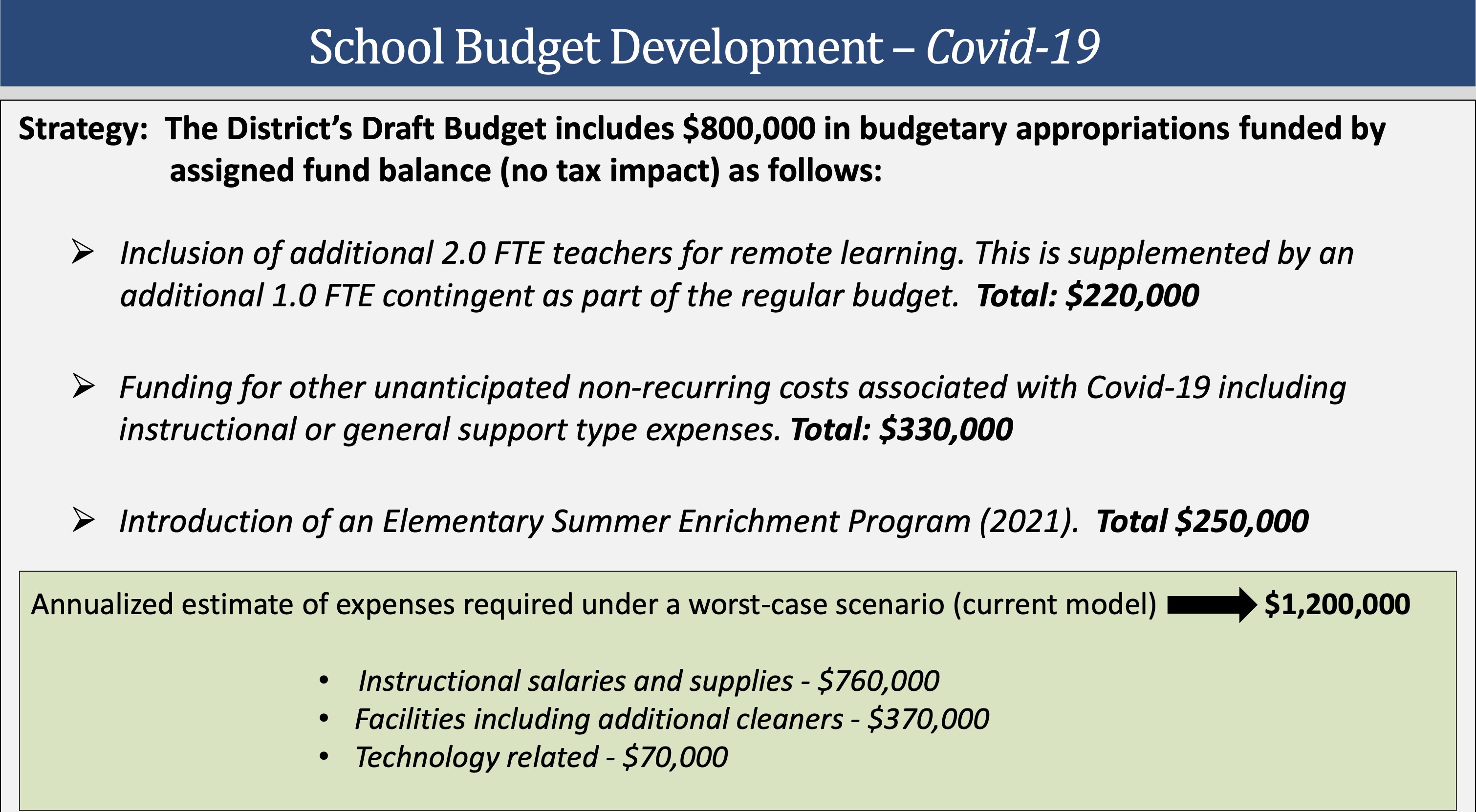 Though the district plans to be back in school in September, in case some hybrid or remote instruction is required, the district has put some contingency funds in the proposed 2021-22 school budget.
Though the district plans to be back in school in September, in case some hybrid or remote instruction is required, the district has put some contingency funds in the proposed 2021-22 school budget.
Summer Enrichment Program: Administrators are currently trying to gauge community interest in the enrichment program as they consider what the next steps should be. The goal of the program will be to enrich students’ literacy and mathematics development, and it will be open to all students who completed kindergarten through fifth grade. It will be staffed by Scarsdale teachers. Students who do not attend will not miss essential content, as the program will feature project-based learning activities that will engage students with skills and concepts they have already learned. They discussed the possibility of coordinating the program with the summer camp offered by the Village so that students could attend both the enrichment program and the Rec Day Camp.
Because the development of the program is based on community interest, Board member Ron Schulhof asked what the minimum number of students would be necessary for the program to run. Dr. Edgar McIntosh, the Assistant Superintendent for Instruction, stated that although exact figures have yet to be determined, the administration estimates that around 15% of students will be interested in the Enrichment Program and that this figure will make the project feasible.
Next, the Board reviewed the primary budget drivers for the proposed 2021-2022 budget.
The total impact of these changes is $3.816 million and includes:
• Contractual salary increases for all employees - $2.1677 million
• The District’s self-funded medical insurance budget increase due to plan experience and employee contributions - $922,000
• Covid-19 contingency funded from prior year surplus - $800,000
• Transfer to school lunch fund to cover losses - $175,000
• Contractual increases and improvements to security - $169,000
• Plan operation and maintenance for HVAC and electrical maintenance and snow removal equipment - $161,000
• Debt service - $151,000
• Transfer to Capital Fund ($379,000)
• Tax Certiorari decrease ($350,000)
Board member Amber Yusef later asked for details about increased security costs and Mattey said the District plans to update its process for an automated lockdown by integrating all of its systems with the process for alerting the police and the fire departments of the situation.
Fund Balance: As of June 30, 2020, the district fund balance was $26,664,738 which is projected to decrease to $23,035,349 by June 30, 2021. The unassigned fund balance will drop to $4,666,306 which is 2.8% of the draft budget. Customarily, the district retains 4% in the unassigned fund balance for unanticipated expenses.
Next, the Board reviewed several individual pieces of the budget, including transportation, debt service and lease purchases, employee benefits, and interscholastic athletics.
Transportation expenses account for approximately 3% of the Draft Budget. In the 2020-2021 budget, the actual cost was $4.173 million, and this year’s budget projects the cost at $4.544 million. This accounts for the continuation of all current policies, 63 bus drivers, and the planned purchase of 1 large bus, 2 mini-busses, and 1 van. This figure also accounts for contractual salary increases.
Debt Service and Lease Purchasing accounts for 6% of the budget. In 2020-2021, the actual cost for this expense was $7.281 million, and the proposed cost in this budget is a 2% increase, resulting in a $7.491 million expense. This includes a continuation of the District’s technology lease purchasing plans, computer lease payments, and copier replacement plans.
Employee Benefits comprises 22% of the proposed budget. This expense was $36.805 million in the 2020-2021 fiscal year, and it is projected to increase to $37.241 million for the 2021-2022 year. This includes employee insurance costs, New York State retirement system costs, and other insurance expenses.
On a percentage basis, one of the largest increases in the proposed budget is for athletics, which totaled $1.858 million for 2020-21, and is projected to go up to $2.171 million for 2021-22. This represents a budget-to-budget increase of 9.42% to fund supplies, uniforms, sports entry fees, certification expenses, equipment, and equipment reconditioning.
The primary reason for the increase is to fund athletic training supervision and coaching. Director of Physical Education, Health & Athletics, Ray Pappalardi explained that it has become a standard best-practice to have an athletic trainer on standby to help with any potential injuries during events. The district currently has one full-time athletic trainer, and there were gaps in coverage during sports practices and competitions. For example, Mr. Pappalardi stated that oftentimes during football season, one athletic trainer must be with the team at an away game and it would benefit the District to have an additional trainer on staff to circle around to home team fields. In addition to football, other higher-risk teams would benefit from an offsite trainer during events and competitions.
Following the presentation, the Board posed questions about the STAR Rebate Program which may be changed by the state along with the decrease in the unassigned fund balance which could pose risks down the line. They asked for the cost for additional furniture and equipment to bring third through fifth graders back to school were in the budget and learned that this expense has not been planned for as yet. These funds will have to come out of the fund balance, which will decrease. However, these expenses may be offset by state aid which may come in but is not counted in this proposed budget.
The next budget meeting will be held on March 1 and will include a Draft Budget plan update and department budget presentations. The third budget meeting will be held on March 8 and the Budget Forum and Review will take place on March 22. Finally, the Board of Education will adopt the budget on April 12 and the final vote will take place on May 18.
Nominating Committee Seeks Candidates for Scarsdale Board of Education
- Details
- Written by: Joanne Wallenstein
- Hits: 2532
 The School Board Nominating Committee (SBNC) is seeking to identify potential candidates to serve on the Scarsdale Board of Education. The SBNC held its first meeting of the 2021 season on January 24th and is now engaged in active outreach to build a robust candidate pool.
The School Board Nominating Committee (SBNC) is seeking to identify potential candidates to serve on the Scarsdale Board of Education. The SBNC held its first meeting of the 2021 season on January 24th and is now engaged in active outreach to build a robust candidate pool.
Over the next several weeks, SBNC members will recruit and review candidates in order to nominate two candidates for the nonpartisan slate in the next school board election. The school board election and budget vote are slated for Tuesday, May 18, 2021. Of the two school board members who will complete three-year terms this year, only one of them is eligible for renomination. Board President Pam Fuehrer will complete two terms this year and Board Vice President will complete one term and is eligible for nomination.
The SBNC invites all Scarsdale School District residents to propose names of qualified individuals to serve on the Scarsdale Board of Education by email to sbncchair@gmail.com. A candidate must be at least 18 years old, a U.S. citizen, a qualified voter, and a resident of the Scarsdale School District for at least one year prior to the May 18th school board election date. Nikki Hahn, SBNC Chair, stated: “The non-partisan SBNC process is critical to the excellence of our Board of Education and our schools. This year we will be proposing two candidates for the Board, and we hope service-minded residents will embrace this opportunity to help shape the educational policies that profoundly affect the children of our community.”
Interested candidates should complete a biographical information form and submit it via email to the SBNC Chair, Nikki Hahn, at sbncchair@gmail.com as soon as possible, but no later than 11:59pm on Tuesday, February 23, 2021. Application form is available on the SBNC website at www.scarsdalesbnc.com. Please see the “Join the School Board” tab or contact the SBNC Chair for further information.
Contacts:
Nikki Hahn, Chair
Kerry Hayes, Vice Chair
Westport Elementary and Middle Schools to Reopen to Full Time Learning
- Details
- Written by: Stacie M. Waldman
- Hits: 4136
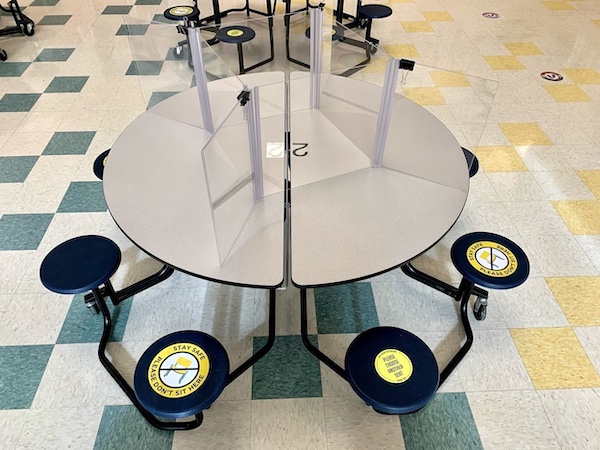 Plexiglass divides a lunch table in a middle school cafeteria.Westport Connecticut is like Scarsdale in many ways. It is a train-ride away from Manhattan, it is socially progressive, wealthy and has a similar number of kids in the public school system. Like Scarsdale, Westport places a huge emphasis on public education.
Plexiglass divides a lunch table in a middle school cafeteria.Westport Connecticut is like Scarsdale in many ways. It is a train-ride away from Manhattan, it is socially progressive, wealthy and has a similar number of kids in the public school system. Like Scarsdale, Westport places a huge emphasis on public education.
Beginning next week, K-8 students in Westport will return to full in-person learning, with the high school to follow.
The decision was made by Westport’s relatively new School Superintendent Thomas Scarice, who took the reins in July 2020 and vowed to safely and effectively fully open schools as soon as possible in the 20-21 school year.
Westport Public Schools began the 2020 school year in a hybrid learning model, similar to Scarsdale’s model. At the K-5 level, children were broken into two cohorts, A and B. These cohorts attended school in-person daily in the morning or the afternoon, switching schedules each quarter, with every other Wednesday scheduled for at-home learning. Anyone who had to quarantine due to exposure at school or on the bus, at the elementary level, missed two full weeks of in-person teaching as there was no at-home live teaching option, just self (or parent) guided learning.
Middle School and High School students were separated into cohorts a well, attending school twice a week for full in-person days. At home learning days were on Zoom with their teachers and classes. Wednesdays were live-Zoom half days. Quarantined kids could easily switch to remote learning.
Surveys were sent out to parents prior to the start of school and twice since then, asking parents to commit to distance learning or a hybrid model (and now distance learning or in-person, full time). Full distance learning will remain an option for all Westport Public School students during the 2020-21 school year.
When he announced the move to full- time school, Scarice wrote a lengthy position letter to all members of the school district. He cited, “four months of experience in preventing virus transmission in our buildings” as well as success of surrounding districts that have returned to full-time, in-person learning. He had given administrators a deadline of January 8th to submit tentative plans for reopening. Many internal discussions were held and the superintendent decided that schools could and would open with a stringent set of guidelines and a plan to rethink them if necessary.
Knowing that this would come with controversy, especially because vaccinations were just starting, Mr. Scarice outlined the reasons for his decision.
First and foremost, he stated, “…our primary mission is to serve and develop our students…we are also obligated to balance our public health responsibilities with perhaps less obvious risks that have impacted our children as a result of the reduction of on-site schooling.” He goes on to criticize the lack of news about the academic, social, emotional and psychological impact that COVID-19 has had on school-age children. Scarice believes we are just beginning to see the negative impact COVID has had on children. He argues that, “…it is time to move these two obligations a bit more into balance.”
At the elementary level, students will return to full on-site schooling (if their parents choose this option) on Monday, February 1. They will continue to be required to wear well-fitting masks properly at all times except when eating. Wednesdays will be on-site half days to be able to offer help to teachers with the new teaching environment in the afternoons. Lunch and snack will be in the classrooms although some students may be moved to other areas of the school for spacing purposes. Students will maintain social distancing to the greatest extent possible and all desks will have plexiglass barriers.
Middle Schools (of which there are two) will also begin full on-site schooling February 1. In February, Wednesdays will have half-day distance learning to give teachers time to transition with the goal of having middle school students back full time, five days a week beginning March 1. Lunch will be in the cafeteria and the school has set up tables with large plexiglass dividers in order to minimize interaction.
The high school will continue to operate under the hybrid model until further notice, but the plan is for full on-site learning as well in the coming weeks.
Mr. Scarice acknowledges the risks of the full re-opening. Increased numbers of students and staff may have to quarantine if they are in close contact with a positive case. School closures may occur due to staffing issues. Buses will be more crowded and drop-off and pick up will be busier. Furthermore, and importantly, he expects to see a 5-10% increase in people choosing the full distance learning option as has been evidenced by other schools opening up.
The superintendent closed his letter by saying “I am confident that through our resilience we will continue to maintain high levels of safety for staff and students,” noting that adjustments may need to be made along the way.
Responses have been very mixed in Westport. One parent said, “Hooray! I have been disheartened to see that if you’re a child, you can’t go to school but you can go bowling, out to dinner or on vacation to Vail.” Other parents are horrified that teachers are expected to teach to full classrooms prior to being vaccinated.
Following his announcement, recent headlines included a report released by the CDC that found that the risk of COVID-19 transmission in the schools is minimal when mitigation factors are in place like masks and social distancing. Margaret A. Honein, the lead author of the JAMA/CDC report, said, “…the data has really accumulated,” something they didn’t have at the start of the school year. The researchers said they were far more concerned about indoor sports and other extracurricular activities that do not allow for distancing and mask use than the controlled environment of a school setting.
Furthermore, this week the CDC urged schools to reopen with precautions in place and a New York Times article documented a rash of child and teen suicides in a Las Vegas school district.
Read Mr. Scarice’s letter below:
Welcome to 2021
As we complete our second week since returning from the winter break I would like to take this opportunity to wish everyone a very Happy New Year and to provide updates to the school community.
In the short time since our return, we have experienced the tragic loss of a beloved member of the student body, Staples senior Timari Rivera, and an historic and unspeakable act of violence on our nation’s capital, all while we continue to confront educating our students in a pandemic.
This school year has been a physical, emotional and psychological test of our collective endurance. We close out the first half of the school year at the end of this month. In the midst of the uncertainty and episodic chaos, I hold a very optimistic perspective for the second half of the school year.
What’s Next
As I shared with the parent community on December 22, 2020, I recommended a cautious approach to our school reopening this year. However, based on four months of our experience in preventing virus transmission in our buildings, and the similar success of peer districts in our region who have been fully reopened, along with the reopening of Coleytown Middle School, I began conversations to intended increase access to on-site schooling for the second half of the school year. These discussions included a full reopening of on-site schooling for all K-8 students and increased access for on-site schooling at Staples.
As a refresher, I asked the administration from each of the three levels to have plans ready for my review by January 8. I received those plans and held numerous discussions this week to determine the most appropriate approach. More specific plans are ready to be shared. Yet, this week was critical in conducting internal discussions.
We have remained on the course I illustrated for the school community on December 22. There is a great deal of work that has been done, and continues to be done, to safely welcome our students back for additional on-site schooling. However, we remain on the timeline shared on December 22.
I will share the overall next steps in this communication, while each building principal will share the details as it relates to their school and their students in the coming days.
The “Why?”
Those who serve our students, namely our faculty and support staff, are the reason for our success. Our collective support of these professionals is critical to the success we have enjoyed for decades. Yet, as a system, our primary mission is to serve and develop our students. In the course of this work, challenges emerge in an ordinary year. In a pandemic the challenges grow exponentially.
As a community, we are faced with obvious public health obligations to ensure that we are responsibly doing our part as a school system to minimize virus transmission. However, we are also obligated to balance our public health responsibilities with the perhaps less obvious risks that have impacted our children as a result of the reduction of on-site schooling.
The academic, social/emotional, and psychological impact on our students is not captured each evening on the news in cases per 100,000, or in positive test rates. Yet, the impact is real, consequential, and warrants mitigation.
It is time to move to bring these two obligations a bit more into balance.
In October, the district partnered with the Tri State Consortium and conducted focus groups with almost 250 teachers, students and parents to identify critical problems for us to solve this year as a result of delivering a pandemic education. Many of the problems that were identified can be addressed, in part, through greater access to additional on-site schooling. The lack of connections with peers and adults, the academic struggles, and the ongoing challenge of engaging students can all be tempered with additional on-site schooling. This move will not eliminate these problems, nor will it eliminate the profound social/emotional and psychological issues that have emerged for some children, but it will ease the effects on the children we serve.
The benefits full on-site schooling are so important, particularly after long periods of remote and hybrid instruction this year and last year, that bringing our responsibilities to public health and our students into balance is warranted.
With less pandemic experience in the fall, I was less inclined to increase the levels of on-site schooling, particularly at the elementary level which provided an “everyday” model. A move to a “pandemic classroom” was not warranted given the uncertainty of the coming months in the fall. That said, given our experience since then, and the experience of our peers in the region, along with the significant benefits of full on-site schooling, in my judgement it is time to begin this transition.
The Transition Process
Elementary Schools
The transition to full time on-site schooling will begin with a full asynchronous remote day for all elementary students on Wednesday January 27 in order to provide teachers the time needed to accommodate their classrooms for full enrollment. A special two day transition schedule (January 28 and 29) will be shared next week by the elementary principals to their school communities which will illustrate how they will gradually welcome back their entire student body, with the first full K-5 day of on-site schooling scheduled for the first day of the second half of the school year, Monday February 1.
From that point forward, elementary students will engage in full school days, with changes made to arrival/dismissal, bus seating assignments, lunch, and recess. The principals will communicate this information, and more, to their families in the coming days.
Given the need for our elementary faculty to deliver their instruction in a pandemic setting, and all of the professional challenges associated with this, like most districts in our region, Wednesdays will remain an on-site half day for students. Afternoons will be reserved for teachers to work with colleagues as they continue to solve instructional problems unlike any they have experienced in their careers as a result of COVID-19.
Lunch will be served in homerooms and efforts will be made to “dedensify” the classrooms where appropriate when serving lunch by accessing other areas of the school building. There will be no cohort switch on January 25.
A parent survey is forthcoming which will gather information on any changes in distance learning requests from parents and transportation intentions (i.e bus or bring your child to school).
The distance learning option will remain for students and this program will be largely unchanged, providing consistency for this population of students. More information about the distance learning option will be provided by the elementary principals in communication to their families.
Middle School
The middle schools will also transition to full time on-site schooling on the first day of the third quarter, February 1. The middle schools will transition the first phase during the month of February and the second phase on March 1. Phase 1 will have all students return in person for full day instruction on Monday, Tuesday, Thursday, and Friday, while maintaining the existing Distance Learning half-day schedule on Wednesdays (February 3, 10 and 24 only). Phase 2 will commence on March 1 with students attending school in person all five days; eliminating the
Distance Learning Wednesday
The middle school principals will communicate directly with their families in the coming weeks. In short, the current daily schedule will continue to be implemented to make the transition easier for our students. Additional mitigation measures will be implemented where appropriate.
A parent survey is forthcoming which will gather information on any changes in distance learning requests from parents and transportation intentions (i.e bus or bring your child to school). Distance learners at the middle school level will continue to have access to live streaming.
High School
Like the elementary and middle school levels, the Staples team has also developed plans for an increase in on-site schooling for students. However, given our tragic loss last week and the impact on the school of working with students to process the events at the nation’s capital, for good reasons, the Staples plans are a week or so behind schedule. In full candor, my expectation last week was that the Staples team would fasten their attention to the work of supporting students and staff as a result of a heartbreaking loss to the school community.
That said, it is expected that these plans will be reviewed and considered for implementation in the coming weeks. The perhaps less obvious effects of the pandemic (social/emotional, psychological) have hit our high school population particularly hard and we have an obligation to respond. I am confident that we will.
The Unintended Consequences
Along with perhaps lessening the negative academic, social/emotional and psychological effects of the pandemic on our students, there will be some unintended consequences. With more students on site it is very likely that we will see increased numbers of students and staff recommended to quarantine in light of being considered a close contact to a positive case.
Additionally, it is also likely that in some instances, a full, temporary school closure might be warranted in response to a positive case that includes many close contacts. Staffing our schools has been a challenge and that challenge has the potential to grow during full on-site schooling.
We expect an increase in the number of distance learners as this has been the case with our regional peers. Districts in the region that have successfully transitioned to full on-site schooling have reported a 5%-10% increase in distance learners at the outset of implementing full on-site schooling.
Finally, our buses will likely see more students on board. Vigilance in mask wearing on our buses, and in all settings will be critical to our continued success.
Final Note
As I shared on December 22, given the performance of public schools across the state, and here in Westport, I am confident that our resilience will continue to maintain high levels of safety for staff and students. It is clear that with continued vigilance in mask wearing, schools can remain resilient while serving more on-site learners safely. Of course, for this school year all parents will be afforded the right to distance learning for their child.
Communication throughout the system will be essential to making appropriate changes as necessary. We will continue to monitor our performance and the effectiveness of our safety measures. In response, we reserve the right to make programmatic adjustments along the way.
You can expect building principals to follow up with families in the coming days as we prepare for this change in learning models.
Sincerely,
Thomas Scarice
Superintendent of Schools
Writer Stacie M. Waldman is a mother of two and a former Westchester resident who now lives in Westport, CT.










